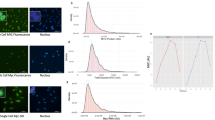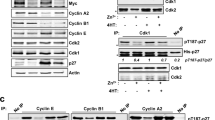Abstract
The steady-state messenger RNA levels of several genes increase when cells are stimulated to proliferate1–4. The transcripts from one such gene, the proto-oncogene c-myc, increase approximately 20-fold shortly after cells are stimulated to proliferate and then decline before the onset of DNA synthesis1,5. It has been inferred from these data that expression of c-myc may be specific to the G1 portion of the cell cycle5. Alternatively, this transient increase in c-myc mRNA following the stimulation of quiescent cells could be the result of an activational event that renders the cells competent to enter the cell cycle. To distinguish between these possibilities, we performed experiments to determine whether the amount of c-myc mRNA fluctuates during the cell cycle in cells that are under constant stimulation to proliferate. Although c-myc mRNA does undergo a transient increase within 2 h of serum stimulation of quiescent serum-deprived cells, our results show that the level of c-myc mRNA is constant throughout the cell cycle and does not diminish in density-arrested cells maintained in the presence of serum growth factors. In contrast to c-myc, the mRNA levels of two other genes whose expression has been associated with cellular proliferation6–8 do show consistent variations within the cell cycle. Both thymidine kinase (TK) and histone 2b (H2b) mRNA levels increase during S phase in continuously growing cells and decrease when cell replication ceases in density-arrested cultures. Therefore, the transient increase in c-myc transcription following the activation of quiescent cells is not due to the type of cell cycle-dependent regulation characteristic of the TK and H2b genes.
This is a preview of subscription content, access via your institution
Access options
Subscribe to this journal
Receive 51 print issues and online access
$199.00 per year
only $3.90 per issue
Buy this article
- Purchase on Springer Link
- Instant access to full article PDF
Prices may be subject to local taxes which are calculated during checkout
Similar content being viewed by others
References
Kelly, K., Cochran, B. H., Stiles, C. D. & Leder, P. Cell 35, 603–610 (1983).
Greenberg, M. E. & Ziff, E. B. Nature 311, 433–438 (1984).
Goyette, M., Petropoulos, C. J., Shank, P. R. & Fausto, N. Molec. cell. Biol. 4, 1493–1498 (1984).
Campisi, J. et al. Cell 36, 241–247 (1984).
Kelly, K., Cochran, B., Stiles, C. & Leder, P. Curr. Topics Microbiol. Immun. 113, 117–126 (1984).
Johnson, L. F., Rao, L. G. & Muench, A. J. Expl Cell Res. 138, 79–85 (1982).
Groudine, M. & Casimir, C. Nucleic Acids Res. 12, 1427–1446 (1984).
Sittman, D. B., Graves, R. A. & Marzluff, W. F. Proc. natn. Acad. Sci. U.S.A. 80, 1849–1853 (1983).
Alterman, R.-B. M. et al. Molec. cell. Biol. 4, 123–132 (1984).
Thompson, C. B. et al. J. Immun. 133, 2333–2342 (1984).
Grdina, D. J. et al. Cell Tissue Kinetics 17, 223–236 (1984).
Schubach, W. & Groudine, M. Nature 307, 702–708 (1984).
Chirgwin, J. M., Przybyla, A. E., MacDonald, R. J. & Rutter, W. J. Biochemistry 18, 5294–5299 (1979).
Cleveland, D. W. et al. Cell 20, 95–105 (1980).
Osley, M. A. & Hereford, L. Proc. natn. Acad. Sci. U.S.A. 79, 7689–7693 (1982).
Zweidler, A. in Histone Genes: Structure, Organization & Regulation (eds Stein, G. S., Stein, J. L. & Marzluff, W. F.) 339–371 (Wiley, New York, 1984).
Farmer, S. R., Wan, K. M., Ben-Ze'ev, A. & Penman, S. Molec. cell. Biol. 3, 182–189 (1983).
Pledger, W. J., Stiles, C. D., Antoniades, H. N. & Scher, C. D. Proc. natn. Acad. Sci. U.S.A. 74, 4481–4485 (1977).
Chen, C. H., Chanh, T. C. & Cooper, M. D. Eur. J. Immun. 14, 385–391 (1984).
Sekaly, R. P., Ceredig, R. & MacDonald, H. R. J. Immun. 131, 1085–1089 (1983).
Westin, E. H. et al. Proc. natn. Acad. Sci. U.S.A. 79, 2490–2494 (1982).
Hann, S. R., Thompson, C. B. & Eisenman, R. N. Nature 314, 366–369 (1985).
Schlosser, C. A., Steglich, C., DeWet, J. R. & Scheffler, I. E. Proc. natn. Acad. Sci. U.S.A. 78, 1119–1123 (1981).
Krieg, P. A. & Melton, D. A. Nature 308, 203–206 (1984).
Author information
Authors and Affiliations
Rights and permissions
About this article
Cite this article
Thompson, C., Challoner, P., Neiman, P. et al. Levels of c-myc oncogene mRNA are invariant throughout the cell cycle. Nature 314, 363–366 (1985). https://doi.org/10.1038/314363a0
Received:
Accepted:
Issue Date:
DOI: https://doi.org/10.1038/314363a0
This article is cited by
-
Differential gene expression in liver of colored broiler chicken divergently selected for residual feed intake
Tropical Animal Health and Production (2021)
-
Reflecting on 25 years with MYC
Nature Reviews Cancer (2008)
-
A cell cycle regulatory network controlling NF-κB subunit activity and function
The EMBO Journal (2007)
-
Gene knockdown by large circular antisense for high-throughput functional genomics
Nature Biotechnology (2005)
-
Post-transcriptional regulation of cyclin D1 expression during G2 phase
Oncogene (2002)
Comments
By submitting a comment you agree to abide by our Terms and Community Guidelines. If you find something abusive or that does not comply with our terms or guidelines please flag it as inappropriate.



